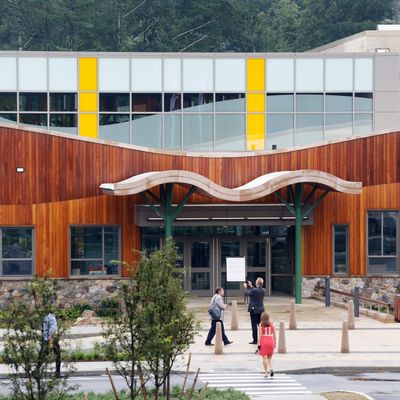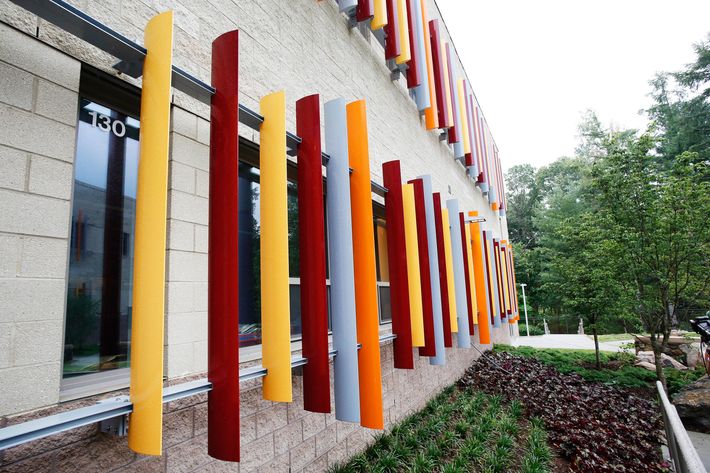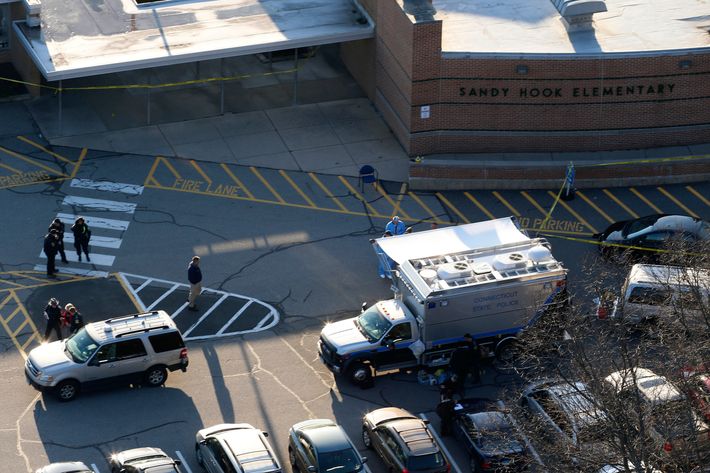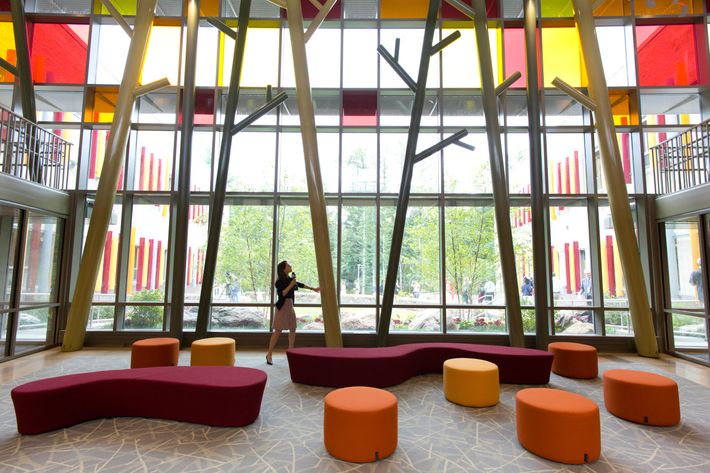
Since December 14, 2012, Newtown, Connecticut, has had a prickly relationship with the press. So many camera trucks swamped the narrow, hilly roads in the hours after the mass shooting there — where 20 first-graders and six educators at Sandy Hook Elementary School were killed — that for weeks even longtime residents didn’t recognize their own neighborhoods. The media overstayed its welcome, eating up all of the bagels and drinking up all of the coffee and asking intrusive questions, and it was all the townspeople — let alone the families of the victims — could do to figure out how to grieve in peace. Newtown welcomed a nation’s thoughts and prayers, but many could not shake the feeling that all this attention was somehow in bad taste — morbid, prurient, a little bit predatory.
So it was odd and unexpected to be invited to a press tour, “a media access day,” of the brand-new Sandy Hook Elementary School on Friday — a first look-see at an architectural resurrection. Not that it ever seemed advisable, exactly, to continue making do with the old school. The old structure retained physical damage from the massacre — Adam Lanza shot his way into the building, and the glass by the front entrance was entirely shattered — but it held tremendous emotional scars as well, for those in the community as much as for those who were actually there. There was the front hallway where the principal, Dawn Hochsprung, was gunned down after looking Lanza defiantly in the face. There were the two classrooms where 20 children and their teachers died unimaginable deaths — and from which a dozen other kids miraculously escaped. First responders who entered the building were forever traumatized by what they saw inside. Parents of surviving children were happy never to have to drive carpool to that parking lot again. Within months, high, impenetrable fences were erected around the site, the long driveway was barricaded, and the construction workers who entered reportedly signed NDAs. No photographs or “souvenirs” ever wound up on eBay.

The old school was razed completely in the fall of 2013, and where it once sat is now, mostly, a ball field, vacant and flat — muddy after a night of hard rain. No marker indicates the old footprint. No stray cinder block belies the former location. Bulldozers did their work and neutralized the physical evidence. And in a parallel effort at erasing the past, the neat white house where Lanza lived with his mother was bulldozed, too; overgrown grasses and shrubs have now utterly conquered the site, as if nature hoped to negate his existence.
The new Sandy Hook Elementary School, designed by New Haven architects Svigals + Partners and built with a $50 million grant from the state of Connecticut, was erected in the same location but sits on a different footprint (the ball field is adjacent to the new school). It is far more beautiful than the old one was. It is also far larger — 88,000 square feet, compared to 66,000 — though it feels intimate, a welcoming structure made of wood and glass. Its first impression is something like a cross between an Adirondacks clubhouse and a suburban megachurch.
But the effect of visiting the school, as an invited member of the press, was like walking through an emotion warp. These dozens of television cameras, these gossiping reporters, these stoic townspeople, these proud architects and builders — all were busy enacting a charade of cheerfulness and qualified optimism. Pat Llodra, the town’s first selectman, who was in charge on the day of “the event” and has carried out her responsibility with a universally admired seriousness and compassion (even as she faces her 75th birthday), tried to address everyone’s discomfort head-on in her remarks. She stood before bouquets of microphones in a freshly painted cafeteria. “We would trade in a minute this beautiful school,” she said, “if we could just change the past.”
Lanza murdered 26 people in about five minutes. What the architects at Svigals + Partners say, as they walk reporters around the place, is that they hoped to create an inviting structure — “as open and transparent as possible,” our tour guide explains. They hope the curves and waves iterated through the design reflect the undulating landscape of the Connecticut countryside. “We wanted the inside to feel like you are outside,” explains our tour guide. “Even the design of the railings is very subtle, but recalls the rolling hills of Newtown.” The school feels “natural,” but “traditional,” too, with cinder-block walls and primary-color blocks accentuating the corridors. There’s a long central hallway, which the architects call “Main Street,” the floors of which are constructed from stained concrete with patches of fall colors — orange, ocher, beige — “recalling pebbled walkways,” our tour guide said.

There’s glass everywhere, vertical, mostly — windows looking out onto “amphitheater” courtyards and gardens and stands of pines. The building tries hard to signal joy, and it would succeed, maybe, if you could believe that the fresh linoleum really meant a fresh start, or forget that the new linoleum and the amphitheater are only here because of “the event.” It isn’t yet easy. We in the press corps waited for the tour to begin in the firehouse parking lot — the same firehouse where in 2012 parents gathered to wait to hear if their children were living or dead. The driveway to the school has been rerouted and now is barred by a security gate, which opens only to approved visitors. All of the glass, everywhere, is bulletproof, Pat Llodra said, and there is a moat, of sorts, between the parking lot and the school. It’s planted with indigenous flowers and advertised as a learning opportunity for kids. The whole place has a playful, tree-house aspect, but indications of its impenetrability are everywhere: This sanctuary is a fortress, too.
In the children’s classrooms, that haunted, gut-wrenching feeling is most intense — inevitable, perhaps, when you see the child-size cubbies and the tiny chairs, the bright-colored blocks, and the library of easy-reader books: Possum Magic, More Spaghetti, I Say! and Marty Frye, Private Eye. Maybe the feeling will be less intense when there are children sitting in those seats and filling the room. Or maybe not — the students are young enough to have been mere babies when the horror occurred and therefore innocent of it in all of the important ways — still, they’re so small! The tour guide wants us to see the white boards, state of the art, and the computers, but it’s hard not to obsess instead over the bathroom and closets and other places where tiny people might hide. Each classroom is connected to another, so “teachers can help each other out if they need to without having to go into the corridors.”
The media presses Llodra, the architect, and the school superintendent to answer questions about new safety features; it’s no surprise that they won’t be specific. “The safety and security measures in this building are second to none,” Llodra says and leaves it at that. In addition to being gated, there are hidden cameras everywhere, they say. Since the shooting, every school in the Newtown district has employed a “school safety officer”: a retired police officer who sits at the front door of the school with a gun.
No one says this out loud, but what the building really looks like is a church. What is perhaps most striking is that it is not exactly a typically pious sanctuary made holy by promises of divine guidance and intervention, but a kind of space sanctified instead by the preciousness of real human lives, cherished flesh, past and present. To that end, the building has to function as an actual school. But during a Q&A session after the tour, reporters wonder whether the dead are memorialized anywhere on the new school grounds, and the answer, officially, is no. There is no memorial plaque, no wall engraved with names, no commemorative photos, no special tree, no angel statue. A more official memorial is in the making: where it will be, what it will look like — these things are still being worked out. But, broadly speaking, the whole building evokes other sacred spaces. The long, vertical arched windows, lit by patches of colored glass, can’t be an accident. Nor can the “gables,” interpretive steeples, or the enormous common spaces hung with twinkling, fluttering mobiles. By the main entrance hangs a series of hand-made bells. “Our intention was to create a space … that honored every single victim, every parent, every student,” Llodra said. In his remarks to the gathered press, Jay Brotman, the architecture-firm partner, said he hoped the new building would be “a place where memory is a blessing.”

The strategic reason for inviting us here, explained Newtown school superintendent Joseph Erardi, is to keep us away when school begins, on August 29. The message: Come and look, help yourself. Take photos of our foursquare courts and our jungle gyms and our bathroom tile and our turtle, “Shelly.” Wonder about the mural in the back entrance that says, “Be Kind.” Obsess over every morbid detail, then, please, leave us alone. Since “the event,” the children of Sandy Hook Elementary School have been commuting to Monroe, ten miles away, where they’ve been going to school in an out-of-use middle-school building. It’s been great, but everyone’s ready to come home. In the past several weeks, at least 700 Sandy Hook families have taken the town up on their invitation to visit the school, and the reactions, Erardi says, has been excited, joyful.
Only about 70 kids enrolled in the school in 2012 will return to the site. On the day of the massacre, they were in kindergarten. (And only about half of them were in school that morning. The other half went to “afternoon kindergarten,” which was canceled that day. ) Now these same children are entering fourth grade — a lifetime in the life of a child, the difference between making scribbles and writing poems. All of the other surviving children, about 300, are in middle school now, moving on into new worlds and new phases of life. They are dealing with their memories however they can. The little kids may be eager to explore their new school, but teachers are more anxious, says Kathy Gombos, Sandy Hook’s principal. They are adults, responsible for children, and they carry the memories and the weight of what happened back to the site. They know that a new structure can’t erase the past. “It’s hard,” she said to me, her eyes welling up. “But when the kids are in front of us, we get busy.”
A duck theme echoes throughout the new building: a duck weather vane, ducks in relief flocking up high walls, little ducks adorning the classroom number plaques. Apparently, families of ducks used to inhabit the fields by the old school, and after December 14, they mysteriously disappeared. These rendered ducks, our guide explained, refer affectionately to those former ducks past. But it’s hard to ignore the obvious metaphor: Couldn’t they refer to the souls or spirits of children, too?






























